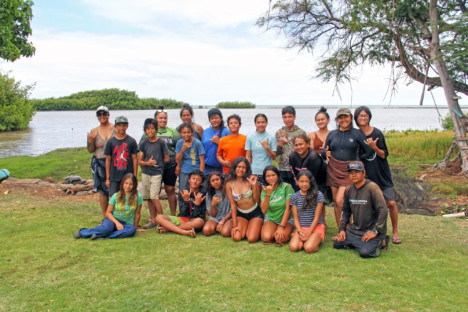Kids Learn While Restoring Hawaiian Fishponds
By Léo Azambuja
Armed with aloha and good intentions, a group of children removed thousands of pounds of invasive species plus some debris from a loko i‘a, or Hawaiian fishpond, on Molokai’s south shore last week.
“Yesterday, they removed invasive species, gorilla ogo, because we have a lot of gorilla ogo on the south shore of Molokai. And then today, we were just taking all the fence that was located by the second makaha (wooden gate),” said Tiani Cook, executive director of the nonprofit organization Ka Honua Momona.
About 15 children enrolled on Maui Economic Development’s summer program worked at the Kaloko‘eli fishpond in Kamiloloa last week. Together with KHM staff, they removed 2,800 pounds of gorilla ogo, a highly invasive algae spread over Molokai’s south shores.
They also removed dozens of invasive mangrove saplings from the pond’s nearshore waters, plus several feet of plastic fencing stuck in the mud near the pond’s rockwalls.
“They learn a lot. They learn about what kinds of fish we have in Hawaii, they learn about pono (responsible) fishing, about the invasive species and why we take it out,” KHM executive assistant Shaye Lauifi said of the benefits the kids get from restoring fishponds.
It’s also about Hawaiian cultural practices. Lauifi said most of the kids who come through KHM are Hawaiians, and caretaking the fishponds keeps them grounded to their culture and gives them a sense of identity.
“We do the Hawaiian protocol. So, before they even came in, they had to oli (chant) into the fishpond, to ask for permission,” Lauifi said.
Besides working on Kaloko‘eli’s restoration, Cook said KHM also does restoration work at the nearby Ali‘i fishpond. Combined, they represent almost 60 acres.
“It’s an ongoing project because we caretake the two fishponds. So, we have got to malama (take care of) both sites,” Cook said. “Summertime is our busy time, because we have more summer groups, there is no school. We have got to keep the keiki busy.”
Cook said it’s important to expose the kids to Hawaiian cultural practices and teach them about sustainability.
“If we don’t have them, who is going to take care of this ‘aina? Who is going to take care of Molokai? So, we try to shape them to become caretakers of Molokai,” Cook said.
There was a time when Molokai had more than 60 loko i‘a spread over its southern shores. Many of these marvels of ancient Hawaiian engineering date back 700-800 years. They provided a supply of fish readily available for harvesting. Some scholars believe the fishponds were mostly to serve Hawaiian royalty.
Once an important part of the Hawaiian ahupua‘a system, the loko i‘a went into decline and disrepair following Hawaii’s Westernization, land development, construction of roads and natural disasters.
Organizations such as KHM and others on Molokai, however, are set to reverse this.
“Our mission is a model of sustainability from mauka to makai, mountain to the sea, and that is what we do,” Cook said.
KHM is supported by grants and donations, and always welcomes volunteers. Their community workday is on every third Saturday of the month. But there are other opportunities for volunteering.
“Come kokua, help us out. It looks hard, but it is fun, because we are fun people. We only work with kind and aloha people, so we aloha them back,” Lauifi said.
Visit www.kahonuamoma.org or follow their Instagram account (@kahonuamomona_molokai) for more information.
“We post everything there, just in case we have to cancel a community workday. Just follow us and you will get updated,” Cook said.
MEO summer program is Monday to Friday, 8 a.m. to 3 p.m. June 2 to July 30. Zantha Tancayo, who runs MEO’s program, said besides volunteering, the kids go on lots of field trips.












Don't have a Molokai Dispatch ID?
Sign up is easy. Sign up now
You must login to post a comment.
Lost Password